Exhibition labels

31: Autumn with Bacchus
Autumn with Bacchus, from The Four Seasons Bacchus, god of wine, is shown with a garland of grapevines and leaning on a cornucopia overflowing with ripe seasonal produce. In his right hand, he holds an elegant grape- filled tazza from...

32: Winter with Aeolus
Winter with Aeolus, from The Four Seasons Winter is personified by a muscly Aeolus, god of the winds, who brandishes a bridle, symbolic of the fast horses that traditionally represented the powerful winds. Between his legs, a small wind-god blows...
34: The Four Elements
Characteristics of The Four Elements – Earth, Air, Fire, and Water – were codified and refined in Ancient Greece and elaborated by Pliny the Elder in his Historia naturalis. The Four Elements and their properties became the cornerstone of Renaissance...
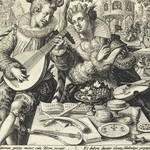
33: Terra (Earth) from The Four Elements
Taste and Hearing are here combined. An elegant couple sits at a dessert table laden with sugar confectionery and succulent fruit. Musical instruments and scores share the spotlight with these earthly delights. The man strums a lute while looking lovingly...
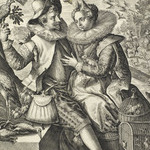
34: Aer (Air), from The Four Elements
Taste and Touch come together in this image alluding to both food and sex. A bird perches on the finger of the hunter, shown with dead songbirds strung from his belt and a waist pouch bulging suggestively with other slain...
37: The Four Temperaments or The Four Humours
According to 2nd-century CE physician Galen, everyone was born with a predominance of one of Four Humours, which governed a person’s Temperament: Sanguine (prone to optimism), Choleric (anger), Melancholic (depression), or Phlegmatic (lethargy). One’s Temperament could be affected by particular...
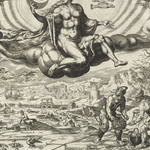
36: Phlegmatici
Phlegmatici (The Phlegmatic Temperament) from The Four Temperaments Luna, goddess of the moon and regarded as a moistening celestial planet, rules over her Phlegmatic people. She is shown in the company of the three ‘water’ signs – Cancer, Pisces, and...

35: Melancholici
Melancholici (The Melancholic Temperament) from The Four Temperaments Harmen Jansz. Müller (c.1540 –1617), after Maarten van Heemskerck (1498 –1574) Netherlands, 1566 Engraving The Rev. R.E. Kerrich Bequest, 1872; received 1873 (M.H-II-150)
37: Sanguinei
Sanguinei (The Sanguine Temperament) from The Four Temperaments Harmen Jansz. Müller (c.1540 –1617), after Maarten van Heemskerck (1498 –1574) Netherlands, 1566 Engraving The Rev. R.E. Kerrich Bequest, 1872; received 1873 (M.H-II-147)
38: Cholerici
Cholerici (The Choleric Temperament) from The Four Temperaments Harmen Jansz. Müller (c.1540 –1617), after Maarten van Heemskerck (1498 –1574) Netherlands, 1566 Engraving The Rev. R.E. Kerrich Bequest, 1872; received 1873 (M.H-II-153)
The Five Senses
The Five Senses The Five Senses – Sight, Hearing, Smell, Taste, and Touch - can be traced back to ancient Greek philosophy, especially to Aristotle, who ordered them into a hierarchy. Sight and Hearing, designated as of most use to...
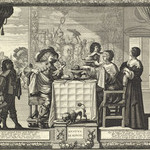
39: Gustus
Le Goust (Taste), from Les Cinq Sens (The Five Senses) As one of the ‘lower’ Senses, Taste was associated with the body and Touch. The image of a couple dining alone is loaded with references to sensual love, most obviously...
50: Book of Hours
This exquisitely illuminated Book of Hours was designed to aid private prayer and this page lists saints’ days between September and December. The Labours of the Months appear at the top of the pages, alternating with the relevant Zodiac sign....
52: Richard Bradley, The Country Housewife and Lady’s Director
Richard Bradley, The Country Housewife and Lady’s Director, in the Management of a House, and the Delights and Profits of a Farm First published in 1732 by Richard Bradley, the first Professor of Botany at Cambridge, The Country Housewife was...
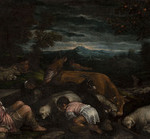
53: Landscape with shepherds
Landscape with shepherds This large canvas portrays an idyllic pastoral scene of prosperous country life with shepherds tending a mixed flock at early dawn, with fruit-laden trees at right, and a majestic mountain range in the distance. With its timeless...

41: Landscape with windmill and carts
Landscape with windmill and carts The power of wind was harnessed by tens of thousands of mills across the landscape of early modern Europe to meet an ever-growing demand for flour. Although Dutch landscape painters often depicted these iconic buildings...
55: Enlarged reproduction of the Porta dedicata alla Vigilanza
Enlarged reproduction of the Porta dedicata alla Vigilanza, from Francesco Orilia, Il zodiaco, over, idea di perfettione di prencipi (Ottavio Beltrano: Naples, 1630), fol. 456 This spectacular life-size cuccagna arch is based on a small woodcut published in 1630. It...
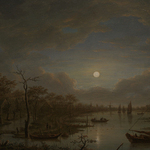
57: River scene by moonlight
A great variety of fish was consumed in early modern Europe. Most people ate salted or dried fish bought at annual fairs and consumed throughout the year. The Church forbade the eating of meat during ‘fast days’ or ‘thin days’,...
56: Winter landscape with bird trap
Winter landscape with bird trap When food was scarcer in the Winter, poorer communities would set up communal bird traps like the simple yet lethal ‘dead-fall’ trap shown in this painting. An old wooden door has been elevated from the...

58: Grus cinera (Trapping cranes near Pisa)
Grus cinera (Trapping cranes near Pisa) This drawing depicts the bizarre and, to modern eyes, barbaric technique used for hunting cranes near Pisa, from which the term ‘hoodwinked’ is derived. The drawing was the basis for a printed illustration published...
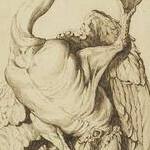
59: A plucked duck
A plucked duck suspended by its neck and one leg This partially suspended, live-plucked duck is a disturbing image of anger and suffering. By excluding any background and making the duck fill the page, de Gheyn has intensified its pain...
61: Swan register
Swans were kept and bred as status symbols by the wealthy, their meat reserved exclusively for elite tables. In England from 1482, it was decreed that all white swans, unmarked, and found in common waters were the automatic property of...
60: Charter
Charter of free warren with the great seal of England, granted to Roger de Pilkington by Edward I Food production and sourcing in early modern Europe were ultimately based on who had access to what and when. Long before 1500,...
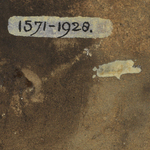
63: Oval plaque
Oval plaque depicting coney catching rabbits Rabbits were a popular food across Europe, and their skins provided useful additional income. Some wealthy English landowners ensured year-round supplies through estate warrens (‘coningerys’). Building a warren required a licence, money, and land...

62: The world turned upside down
Hares roasting a hunter The world turned upside down: Hares roasting a hunter In this tiny print, animals fight back against human aggressors. Normal roles are reversed and animal victims get their revenge. Having caught the hunter, hares spit-roast him...
64: Dead game and fruit
Wild rabbits were caught in snares (traps with anchored wire or cord nooses): the ‘coney’ portrayed here has been snared by its right hind leg. Pheasants were more expensive than rabbits to catch as they were normally shot using guns...
78 & 79: Ice cream spaddle
Ice cream spaddle, and sorbetier from Gunter’s of Berkeley Square, London England, probably early 19th century Pewter; sorbetiere with wooden handle Private collection
80: Hinged tripartite pineapple-shaped ice cream mould
England, c.1790 Pewter Private collection Ice cream was made in the eighteenth century using this sort of equipment. This sorbetier was used in Gunter’s, a fashionable confectionery shop in Berkeley Square, London, which started off life in the 1750s as...
69: John Parkinson, Paradisi in sole paradisus terrestris
John Parkinson, Paradisi in sole paradisus terrestris or, A Garden of all Sorts of Pleasant Flowers which our English ayre will permitt to be noursed up (London, 1629) The notion of the pineapple as a heavenly fruit had gripped the...





